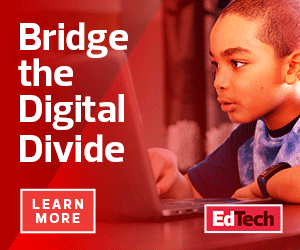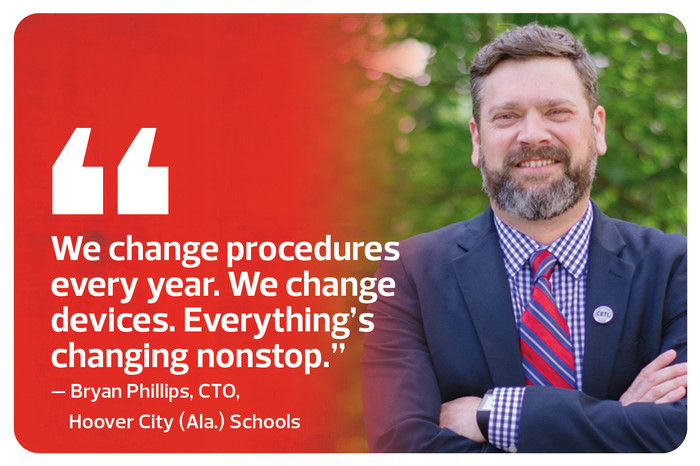Dynamics of digital instruction, learning outcomes and equitable access can be complex, with no one-size-fits-all approach. As researchers learn more about best practices, educators are tasked with putting their findings into practice — a job harder than it sounds. Now, districts are confronting new challenges around equity and screen time as they seek to deliver remote instruction.
We asked Bryan Phillips, CTO of Hoover City Schools in Alabama, to share his views on students and screen time.
This interview is part of a roundtable on how researchers and educators view screen time, digital equity and learning outcomes.
EDTECH: If intentionality is key to effective use of educational technology, how can educators apply this in practice?
PHILLIPS: The teacher is the most important piece of this. We can give them all the tools in the world, but teachers have to understand not to make an assignment that uses a Chromebook just to use a Chromebook. Make an assignment using the Chromebook as a tool to get where you’re going.
In the classroom, technology can be a magnifier: It takes really good teachers and makes them great, and it takes bad teachers and makes them worse.
There are teachers who think technology is a bad thing, but pressure from other classrooms sometimes bleeds over into their classroom. If Johnny goes home and tells his mom about this great activity other students did in Ms. Jones’s class, and that mom talks to another mom and says, “Guess what they’re doing in Ms. Jones’s class? We’re not doing that Ms. Smith’s class,” the pressure slowly grows.
That’s how we’ve grown our one-to-one program. We did a lot of professional development, but with people who were negative to begin with, we let them grow at their own speed as they started asking questions, and I think that helped a lot of the negativity.
If you force something on someone, they’re never going to like it. But given time, they pick it up and enjoy it. The past week has been a great example. A lot of these teachers were not digital, especially the lower grades, but they’re being forced into a digital world now. They still want to see their kids, they still want to interact, so they’re picking it up now because it’s at their pace.
EDTECH: Some educators have concerns about potential negative effects of screen time. Are these concerns legitimate?
PHILLIPS: A teacher needs to be a teacher and take the device away when the device needs to go away. We use tools like GoGuardian, so the teacher can lock everybody’s screen at one time. The teacher can just say, “Stop, close the lids, let’s talk about this,” and actually teach.
EDTECH: How can educators ensure that even if technology is part of the lesson, it doesn’t necessarily become the lesson?
PHILLIPS: Instead of writing an essay to explain whatever the topic is, have them research it or watch a video about it. Give them the freedom to do every lesson in a different way. So if a kid wants to do a video versus writing a paper, let them do that. That’s going to be more beneficial because it’s actually the content they want to know, not the skill on the computer.
EDTECH: How do you frame the relationship between technology and equity?
PHILLIPS: We have kids in our district who live in a $300-a-month apartment. We have kids who live in $7 million homes. There’s no doubt that some kids have access to things that the other kids don’t.
It is our responsibility to give students every tool they need. Sometimes it’s fiscally impossible, but we do our best. We had tablets for two years and loved it, but there was no way for us to take files offline. That’s why we went to a Chromebook. Once we got that freedom, that gave us a little more digital equality.
It’s definitely a big piece of what we work on. We have an equity officer on staff now, and we’ve talked to city officials about making this a Wi-Fi city. That’s down the road, but that’s another huge fiscal responsibility.
MORE ON EDTECH: Watch educators dispell myths about screen time.
EDTECH: What’s changed as schools aim to continue instruction during the pandemic?
PHILLIPS: We worry about our students in multiple-family dwellings who don’t have internet access, so we’re going to take our buses out that have Wi-Fi on them and park them at the complexes to provide connectivity. Having a device opens doors and takes barriers away. This week, hundreds of virtual field trips have been shared online.
EDTECH: Given that our understanding of access and equity issues will continue to evolve, how can schools best approach this complex issue?
PHILLIPS: This is the new norm. We’re seven years into a one-to-one program, and we change policies every year. We change procedures every year. We change devices. Everything’s nonstop changing. You have to be willing to do that, and you have to be willing to fail along the way, learn from the failure and move on.
I was a teacher first, and if you look back to my classroom in 1998 to today, it’s a lot different. I bought my first three computers, and they were all huge Apples that didn’t have internet access. Now we’re giving kids devices that weigh two pounds that they carry around everywhere with them. So it’s come a long way, and it’ll keep changing over time.












